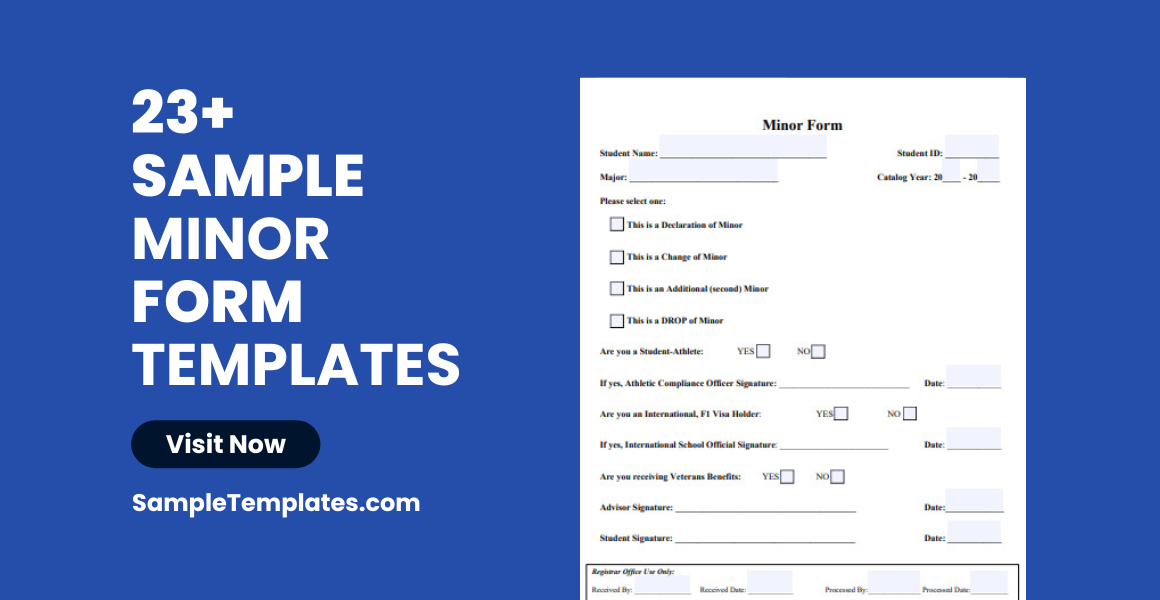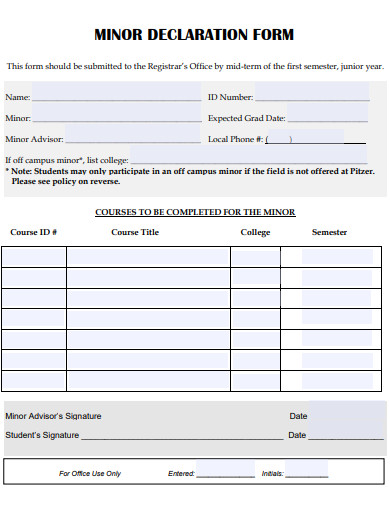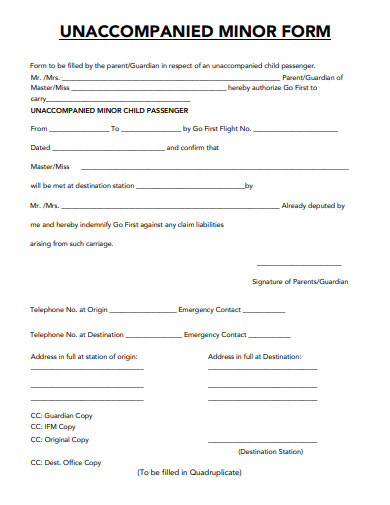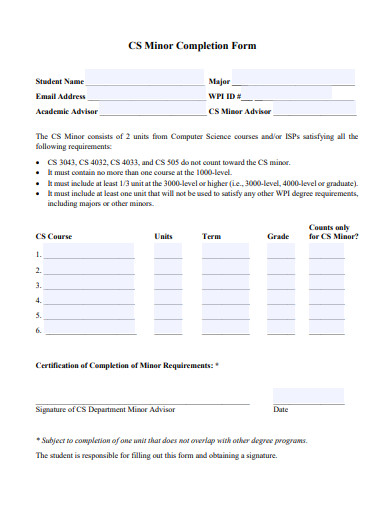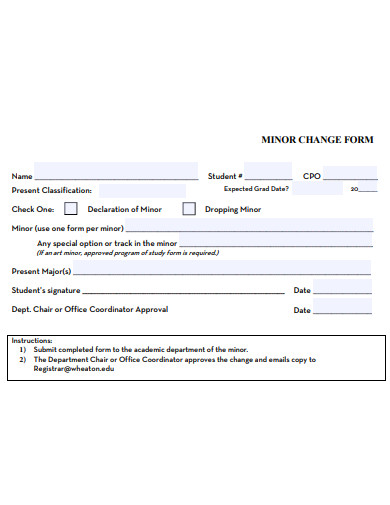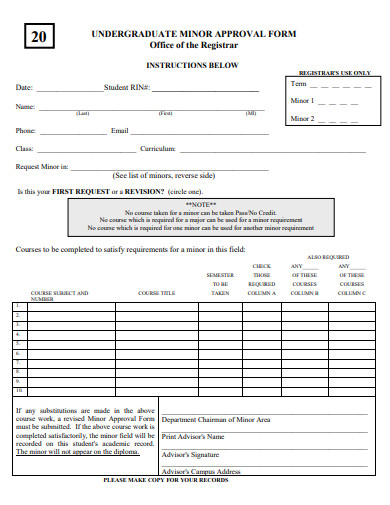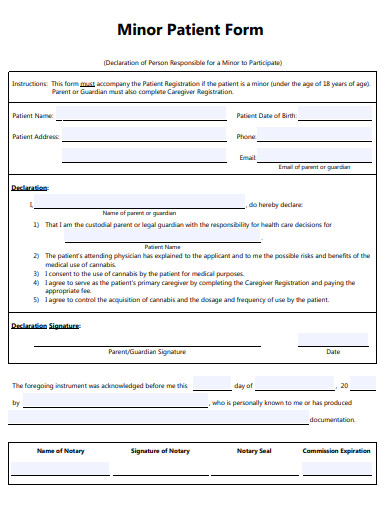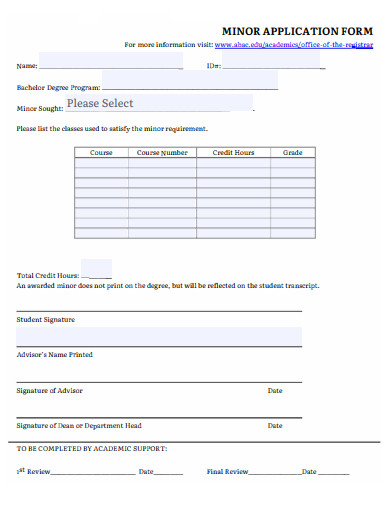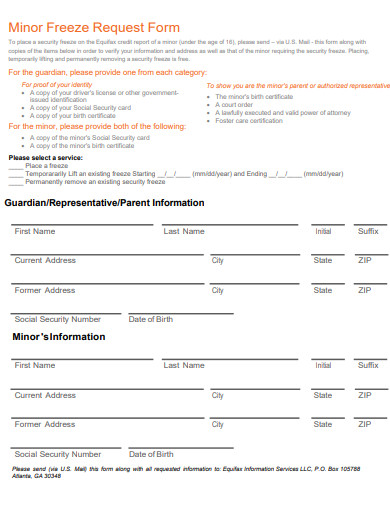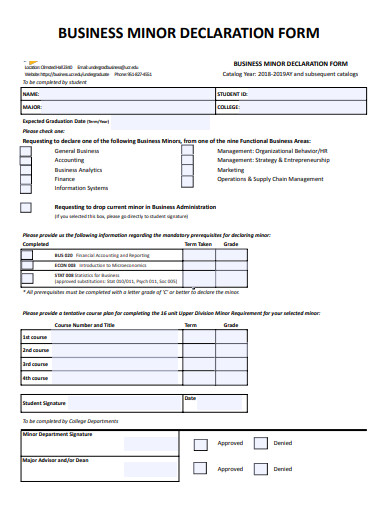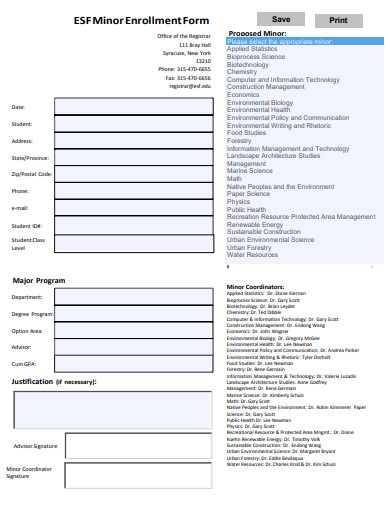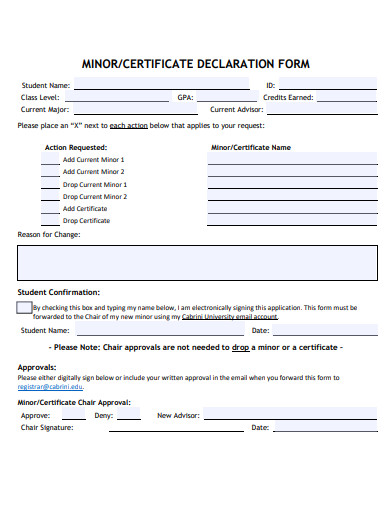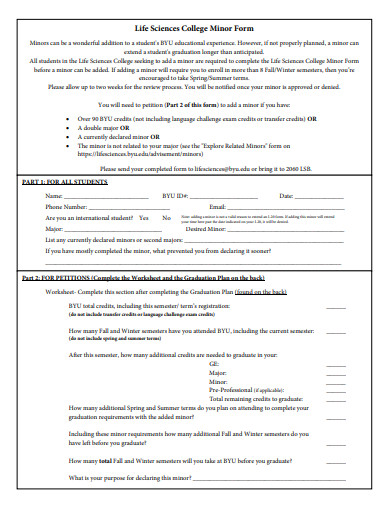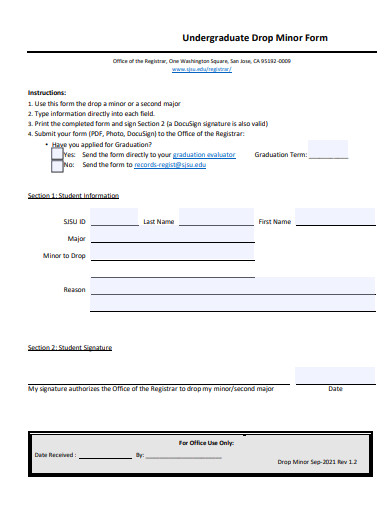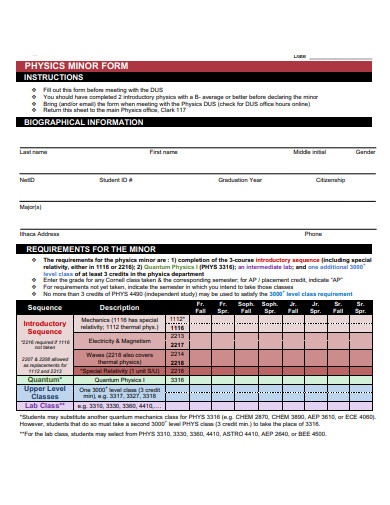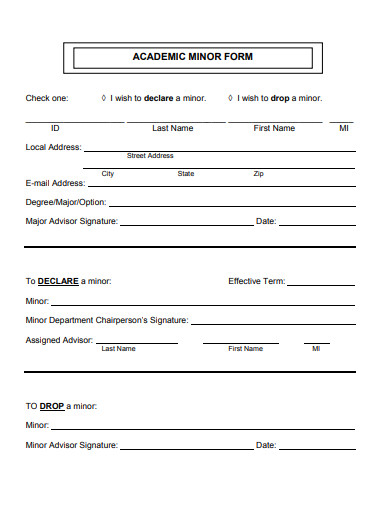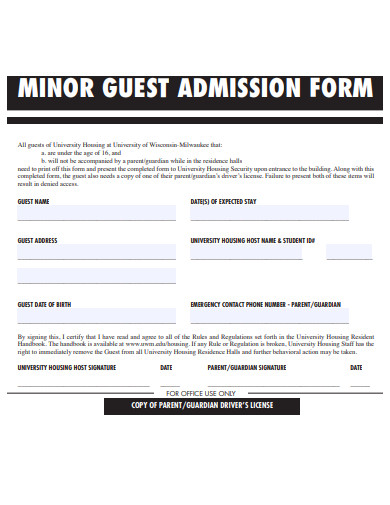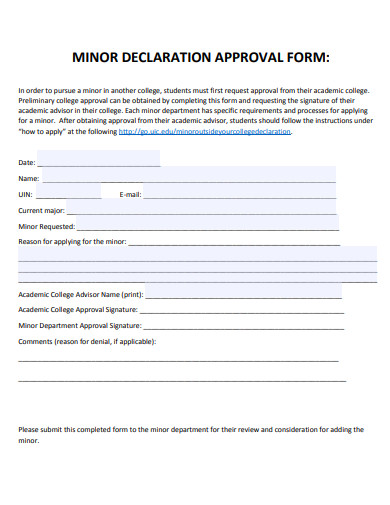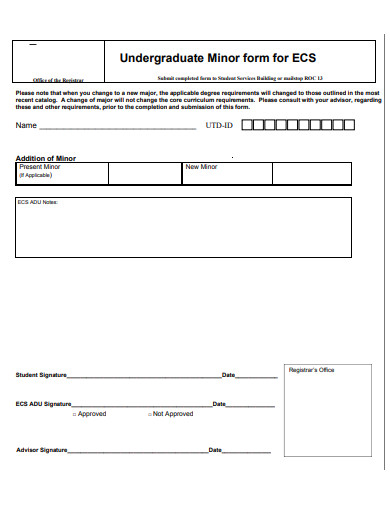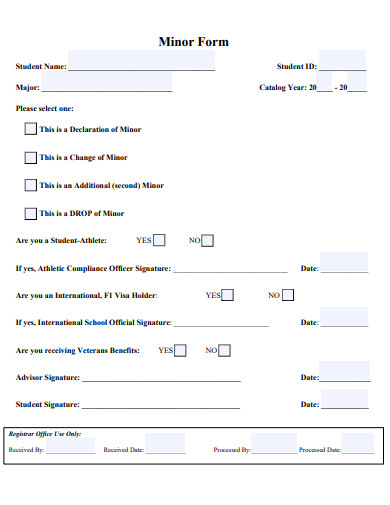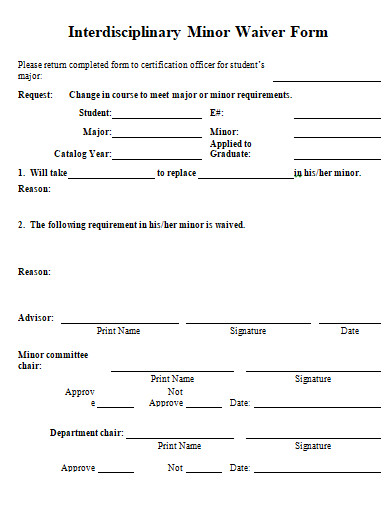In scenarios requiring the documentation of individuals below the age of majority, the ‘Minor Form’ becomes crucial. Whether it’s for parental consents, legal undertakings, or academic registrations, this sample form ensures that the rights and safety of minors are upheld. Balancing clarity with comprehensive detail, a well-structured Minor Form captures essential data while respecting legal boundaries. Dive into our guide to appreciate its importance, design, and the protective role it plays in various contexts.
23+ Minor Form Samples
1. Sample Minor Declaration Form Template
2. Sample Unaccompanied Minor Form Template
3. Sample Minor Planning Form Template
4. Sample Minor Request Form Template
5. Sample Minor Completion Form Template
6. Sample Minor Change Form Template
What is Minor Form?
Minor forms are often discussed in the realms of legal, academic, and medical fields. They refer to design documents or permissions typically associated with individuals under the legal age of adulthood. However, the term can have nuanced meanings depending on the context. Let’s delve deep into understanding what a minor form is and its various implications.
The Necessity of Minor Forms
- Legal Protection: One of the primary purposes of minor forms is to provide legal protection. Whether it’s a school trip or a medical procedure, institutions and professionals want to ensure they have received proper authorization to involve a minor in any activity.
- Informed Consent: Especially in medical scenarios, minor forms can act as a platform to ensure that both the guardian and the minor are informed about the risks and benefits of a particular procedure or treatment.
- Documentation: Having a physical or digital record is crucial. Minor forms serve as proof that due processes were followed, and necessary permissions were acquired. You can also see more templates like Medical Release Forms for Minor.
Key Elements in a Minor Form
While the content might differ based on the context, there are some common elements that any minor form should contain:
- Details of the Minor: This includes the full name, date of birth, and other identification details.
- Guardian Information: Names, contact details, and the relationship to the minor.
- Description of the Activity or Procedure: A clear breakdown of what the minor will be participating in or undergoing.
- Terms and Conditions: Outlining the responsibilities of all parties involved.
- Signatures: Spaces for the guardian, the minor (if appropriate), and the responsible authority to sign. You can also see more templates like Sample Medical Forms.
Types of Minor Forms
- Medical Consent Forms: These are used by healthcare providers to ensure that they have permission to treat a minor, especially in cases where the parent or guardian isn’t immediately present.
- Travel Consent Forms: If a minor is traveling without their parents, they may need a professional form that indicates they have permission to travel, especially for international journeys.
- Educational Activity Forms: Schools and educational institutions often require permission slips for extracurricular activities, especially those that might pose any risk.
- Work Authorization for Minors: Some jurisdictions require minors to obtain permission to work, especially during school hours.
The Process of Obtaining Consent
Obtaining consent is more than just getting a signature on a piece of sample paper. It’s about ensuring the minor and their guardian fully understand the implications of the activity or service. The process typically involves:
- Providing Information: Clearly outlining the activity, its benefits, potential risks, and any other pertinent details.
- Discussion: Allowing the guardian and the minor to ask questions or express concerns.
- Documentation: Once all parties are in sample agreement, the form can be signed as a record of the consent provided.
Digital Evolution of Minor Forms
With the rise of digital platforms and the need for more streamlined processes, many institutions are adopting electronic versions of minor forms. These e-forms offer advantages like easy storage, quick access, and the ability to update or modify information as needed.
Challenges and Considerations
While minor forms play a crucial role in many scenarios, there are challenges. The language used in these forms must be clear and devoid of jargon to ensure understanding. There’s also the challenge of ensuring genuine consent, where the guardian and minor aren’t being pressured or coerced. You can also see more templates like Sample Release Forms.
Why Do I Need a Minor Form?
The question of why one might need a minor form is pivotal, especially for guardians, institutions, or even minors themselves. While the concept of a minor form has been introduced in various contexts, its essence boils down to protection, clarity, and legal adherence. Let’s delve into the reasons why having a minor form is essential.
1. Legal Protection
Arguably the most crucial reason, a minor form offers legal protection to all parties involved:
- For Institutions/Organizations: Whether it’s a school, sports club, or medical facility, having written consent ensures that they have permission to involve or provide services to the minor. This acts as a safeguard against potential lawsuits and disputes.
- For Guardians: These forms also protect the rights of guardians, ensuring that they have explicitly permitted specific actions concerning their ward.
2. Ensuring Informed Consent
Minor forms are more than just about giving permission. They’re about:
- Awareness: The guardian and, where appropriate, the minor, are made fully aware of the implications, risks, and benefits of the activity or procedure in question.
- Transparency: The institution or service provider is obligated to sample outline details, ensuring there are no hidden surprises or clauses.
3. Upholding Minors’ Rights
Children and teenagers have rights, just like adults. A minor form:
- Ensures Volition: It ensures that the minor’s involvement is voluntary and that they’re not being coerced or unduly influenced into participating in activities or procedures.
- Offers a Voice: Especially in contexts where minors are old enough to understand and express their preferences, these forms can act as a channel for their voice and choices.
4. Streamlining Processes
From an operational perspective:
- Easy Verification: Institutions can quickly verify if they have the necessary permissions to proceed with an activity involving a minor.
- Centralized Record-Keeping: These forms can be systematically stored and accessed, ensuring that organizations have a clear record of all consents.
5. Ethical Considerations
Beyond legality, there’s the ethical dimension:
- Respect for Autonomy: By seeking permission, institutions respect the autonomy of the guardian and, by extension, the minor.
- Promotes Trust: It builds trust between organizations and guardians, creating an environment where guardians feel their child’s safety and best interests are prioritized.
6. Potential Financial and Reputational Implications
In the absence of minor forms:
- Financial Ramifications: Institutions might face lawsuits, which can be financially draining.
- Reputational Damage: Organizations can suffer reputational harm if perceived as negligent or careless about minors’ welfare.
7. Evolving Legal Landscape
With the legal landscape around child protection and rights continually evolving:
- Stay Updated: Having standardized minor forms helps institutions stay updated with the latest regulatory requirements.
- Avoid Legal Grey Areas: These forms ensure clarity, ensuring that there are no ambiguities that might land institutions in unforeseen legal complications.
What Information is Required on a Minor Form?
A minor form is a pivotal document, and its accuracy and comprehensiveness are crucial. When drafting or filling out a minor form, certain essential components must be present to ensure its validity and effectiveness. Here’s a breakdown of the information typically required on a minor form:
1. Personal Details of the Minor
- Full Name: The complete legal name of the minor.
- Date of Birth: To confirm the age and verify the individual as a minor.
- Address: Residential details, including street, city, state, and postal code.
- Contact Information: Phone number or email, if applicable.
2. Guardian/Parent Details
- Full Name(s): Names of the parent(s) or legal guardian(s).
- Relationship to the Minor: Specifies whether the person is a parent, legal guardian, or another relation.
- Contact Information: Phone numbers, email addresses, and potentially work or emergency contact details.
- Address: If different from the minor’s.
3. Details of the Activity or Procedure
- Description: A comprehensive explanation of the activity, sample event, service, or procedure the minor will be partaking in.
- Duration: Specific dates or length of time, if relevant.
- Location: Where the activity or procedure will take place.
- Associated Risks: Any potential risks or side effects must be transparently listed, especially in medical or potentially hazardous scenarios.
4. Consent Statement
A clear statement where the parent or guardian acknowledges understanding of the activity and its implications, and grants permission for the minor to participate. This should be worded clearly and without jargon.
5. Liability Waiver (if applicable)
In scenarios where there’s potential risk (like sports or certain recreational activities), there might be a clause where the guardian waives the right to sue or hold the institution responsible should any harm come to the minor, given that all conditions were adhered to.
6. Medical Information (when relevant)
- Medical History: Any past illnesses, surgeries, or health-related issues.
- Allergies: Specific allergies, especially those that might be relevant to the activity or procedure.
- Current Medications: Details of any drugs or treatments the minor is currently undergoing.
7. Emergency Provisions
- Preferred Medical Facility: In case of an emergency, where the guardian would prefer the minor to be taken.
- Special Instructions: Any specific instructions to be followed in an emergency scenario.
8. Signatures
- Guardian’s Signature: The legal guardian or parent signs to authenticate the information and provide consent.
- Date: The date on which the form is signed.
- Signature of a Witness or Notary (if required): Some forms might require an additional signature to further authenticate the process.
9. Contact Details of the Organization/Institution
- Name of the Entity: The institution or individual responsible for the activity or procedure.
- Address: Physical location or mailing address.
- Contact Information: Phone numbers and email addresses for queries or communication.
10. Additional Provisions (if needed)
Depending on the context, there might be:
- Payment details: If there’s a fee associated.
- Instructions or guidelines: Any additional requirements or steps that the guardian or minor should be aware of.
7. Sample Undergraduate Minor Approval Form Template
8. Sample Minor Patient Form Template
9. Sample Minor Application Form Template
10. Sample Minor Freeze Request Form Template
11. Sample Business Minor Declaration Form Template
12. Sample Minor Enrollment Form Template
13. Sample Minor Certificate Declaration Form Template
14. Sample Life Sciences College Minor Form Template
15. Sample Undergraduate Drop Minor Form Template
16. Sample Physics Minor Form Template
17. Sample Academic Minor Form Template
18. Sample Economics Minor Declaration Form Template
19. Sample Minor Guest Admission Form Template
20. Sample Minor Declaration Approval Form Template
21. Sample Undergraduate Minor Form Template
22. Sample Minor Form Template
23. Sample Informatics Doctoral Minor Form Template
24. Sample Interdisciplinary Minor Waiver Form Template
How do you Create a Minor Form?
Creating a form for minors (individuals typically under the age of 18) requires special considerations due to legal and privacy concerns. This kind of form might be used for school registrations, extracurricular activities, medical consent, or any situation where the consent and information of a minor are required. You can also see more templates like Requisition Forms. Here’s how you can create a minor form in five steps:
Step 1: Determine the Purpose and Legal Requirements Before you start designing your form, clarify its purpose. Are you creating a registration form for a school trip, a sports league sign-up, or a medical consent form? Depending on the purpose, there might be specific legal guidelines to follow, especially regarding data protection for minors.
Step 2: Collect Basic Minor Details Begin with the basic details:
- Full Name of the minor.
- Date of Birth to verify age.
- Gender if relevant to the purpose.
- School Grade/Class if it’s education-related.
Step 3: Guardian or Parental Information It’s essential to have the details of the minor’s parent or legal guardian:
- Full Name of the parent/guardian.
- Relationship to the minor (e.g., mother, father, legal guardian).
- Contact Information including phone number, email, and address.
- Emergency Contact Details: Often, a secondary contact is requested in case the primary guardian can’t be reached.
Step 4: Consent and Declarations This section is crucial for forms involving minors:
- Consent Checkbox or Signature Field: For the parent/guardian to provide consent for the activity or purpose of the form. The statement should clearly specify what they’re agreeing to.
- Health or Medical Information: If relevant, especially for activities that might pose health risks or require medical attention.
- Liability Waivers: If there’s potential risk involved, a sample statement where the guardian acknowledges the risks and releases the organizer from certain liabilities.
Step 5: Design, Clarity, and Accessibility Given the sensitive nature of information:
- Keep it Clear: Ensure the form’s language is clear, avoiding jargon. Parents and guardians should understand what they’re agreeing to.
- Privacy Statement: Reassure parents/guardians about data protection measures. Explain how the information will be used and stored.
- Signature Fields: Physical or digital, for both the guardian and, if appropriate, the minor. Date fields should accompany signatures.
- Format and Distribution: Depending on your audience, consider both digital (online submission) and print versions.
In Conclusion, Minor forms serve as a bridge between institutions and guardians, ensuring that minors are protected and that every action taken is with informed consent. Whether you’re a guardian, an educator, a medical professional, or even a minor, understanding these forms and their importance is vital in today’s world. You can also see more template in SampleTemplates.com site!
Related Posts
Sample Sworn Affidavit Forms
Vehicle Inspection Forms Samples & Templates
Sample Employee Advance Forms
Sample Child Travel Consent Forms
Sample Testimonial Request Forms
Sample Employee Details Forms
Sample Divorce Forms
Sample Attestation Forms
Employee Performance Appraisal Form Templates
FREE 9+ Sample Presentation Evaluation Forms in MS Word
FREE 10+ School Admission Form Samples & Templates in MS Word | PDF
FREE 30+ Patient Consent Form Samples in PDF | MS Word
FREE 10+ Sample Sign Off Form Templates in PDF | MS Word
FREE 11+ Sample Medical Consultation Forms in PDF | MS Word
FREE 8+ Sample Donation Forms in PDF | MS Word
